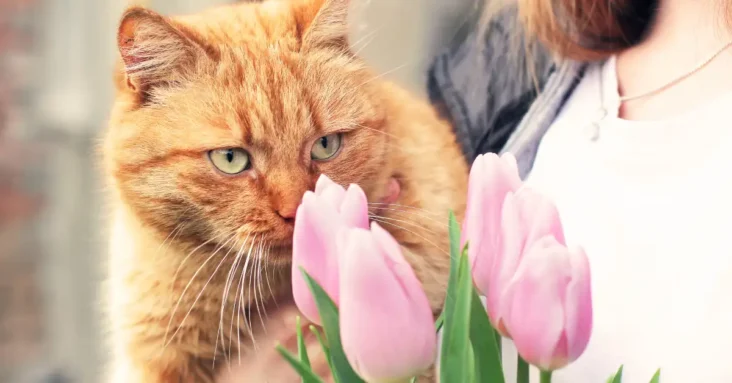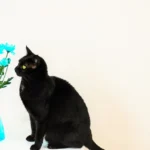You buy a beautiful bouquet of tulips, set it gently in a vase by the window, and admire the pop of color it brings to the room. It’s peaceful—until you turn around and spot your cat sniffing (or worse, nibbling) the leaves. Your heart skips a beat. Is it dangerous?
If you’ve ever wondered whether tulips are toxic to cats, you’re not alone. As cat parents, we’re constantly balancing decorating our homes and keeping them safe for our furry companions.
Let’s talk honestly about tulips, why they can be risky, and how to keep your curious feline out of harm’s way.
Are Tulips Poisonous to Cats?
Yes, tulips are toxic to cats. All parts of the plant—leaves, stems, flowers, and especially the bulbs—contain compounds called tulipalin A and B. Depending on how much they ingest, these substances can cause mild to severe reactions in cats.
Even a small bite can trigger symptoms. While tulips aren’t the most dangerous plant, they’re not cat-friendly.
So if you’re eyeing that spring bouquet or considering planting tulips in your garden, it’s worth understanding the risks.
What Happens If a Cat Eats a Tulip?
Cats process certain plant compounds differently than we do. What might seem harmless to us can upset their entire system. If your cat nibbles on a tulip, the tulipalin compounds can irritate their mouth and stomach lining.
Common Symptoms Include:
- Drooling
- Vomiting
- Diarrhea
- Loss of appetite
- Lethargy
In more serious cases—usually when the bulb is eaten—cats may experience difficulty breathing or changes in heart rate. It’s not common, but it can happen.
And here’s the tricky part: cats are sneaky. They might chew on a plant when you’re not looking and show signs hours later. That’s why knowing the warning signs can make a difference.
Are Certain Parts of the Tulip More Dangerous?
Yes. The bulb of the tulip is the most toxic part. That’s where the concentration of tulipalin is strongest. So if your cat digs in the dirt around potted tulips or outdoor flower beds, they could be at risk, even if they don’t eat the leaves or petals.
But that doesn’t mean the flowers and stems are safe. They can still cause irritation and stomach upset, especially in sensitive cats.
I once brought home a potted tulip as a gift and placed it by the window. My cat, Leo, was immediately interested. He started pawing at the leaves like it was his jungle. I had no idea the plant could be toxic until I googled it—and immediately moved it outside. Thankfully, he didn’t eat any, but I learned my lesson quickly.
Why Are Cats Drawn to Plants Like Tulips?
It’s funny, isn’t it? With all the toys and catnip in the world, some cats would still rather chew on your houseplants.
Cats are naturally curious. The texture, smell, and movement of leaves can catch their attention. Some cats chew on plants out of boredom or instinct, while others do it to get your attention.
If your cat has a habit of munching on greens, it might be time to rethink what you bring into the house.
What Should You Do If Your Cat Eats a Tulip?
First, try not to panic.
Check how much of the plant they ate, if possible. If you saw it happen and it was just a nibble, monitor your cat closely for a few hours. Watch for any of the symptoms listed earlier.
Call your vet immediately if your cat starts vomiting, drooling, or acting strangely, or if you suspect they ate part of the bulb.
It helps to take a photo of the plant or bring a piece to the vet. This makes it easier for them to confirm what your cat may have ingested.
There’s no specific “antidote” for tulip poisoning. Still, most cats recover well with quick treatment (usually fluids and meds to protect the stomach).
Safe Alternatives to Tulips
You can still have a beautiful home and keep your cat safe. Plenty of flowers are non-toxic to cats and look as lovely in a vase or garden.
Cat-Safe Flower Options:
- Roses (without pesticides)
- Snapdragons
- Marigolds
- Zinnias
- Gerbera daisies
- Sunflowers
You can also try growing a little cat grass indoors. Not only is it safe, but many cats love it—and it might just keep them away from your more delicate plants.
How to Keep Tulips Out of Paw’s Reach
You can still take precautions if you absolutely must have tulips, either as a gift or a seasonal treat.
Tips to Stay Safe:
- Please place them in a room your cat can’t access.
- Use hanging baskets or high shelves (though some cats are skilled climbers).
- Consider faux tulips—some beautiful, realistic silk versions are out there.
- Keep bulbs out of reach during planting season, and fence off garden areas if needed.
A friend of mine keeps her tulips on her balcony during spring and only brings them inside when guests come over. It’s a small effort that relieves her from worrying about her two mischievous kittens.
Are Dogs Affected Too?
Yes, tulips are also toxic to dogs, though, unlike cats, dogs are more likely to dig up and eat bulbs. So if you’re a multi-pet household, the tulip ban might need to be a house rule for everyone.
Why It Matters More Than You Think
Cats are resilient, but their bodies aren’t built to handle certain plant toxins. And when you think about how standard tulips are, especially around spring, it’s worth being cautious.
It’s not about living in fear. It’s about being aware, making thoughtful choices, and knowing how to react if something goes wrong.
Because let’s be honest—our cats are family. We’d rather change our décor than risk their safety, right?
A Little Beauty, A Big Risk
Tulips are stunning. They bring light and color into any space. But when you live with cats, beauty has to come with responsibility. Knowing that tulips are toxic to cats can help you make safer choices for your home—and possibly avoid an emergency trip to the vet.
So go ahead and enjoy flowers—just make sure they’re the kind your cat can enjoy too. A little awareness today can mean a safer, happier tomorrow for your curious little companion.







GIPHY App Key not set. Please check settings